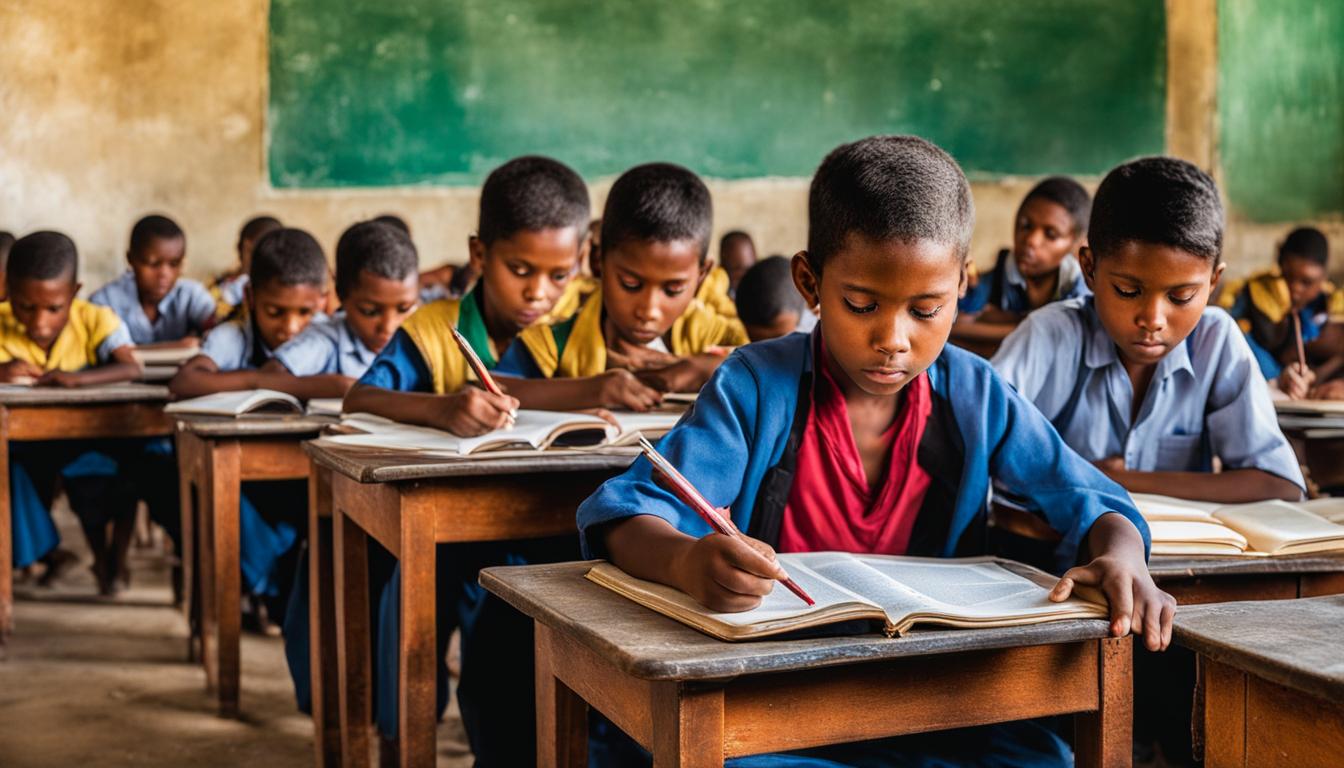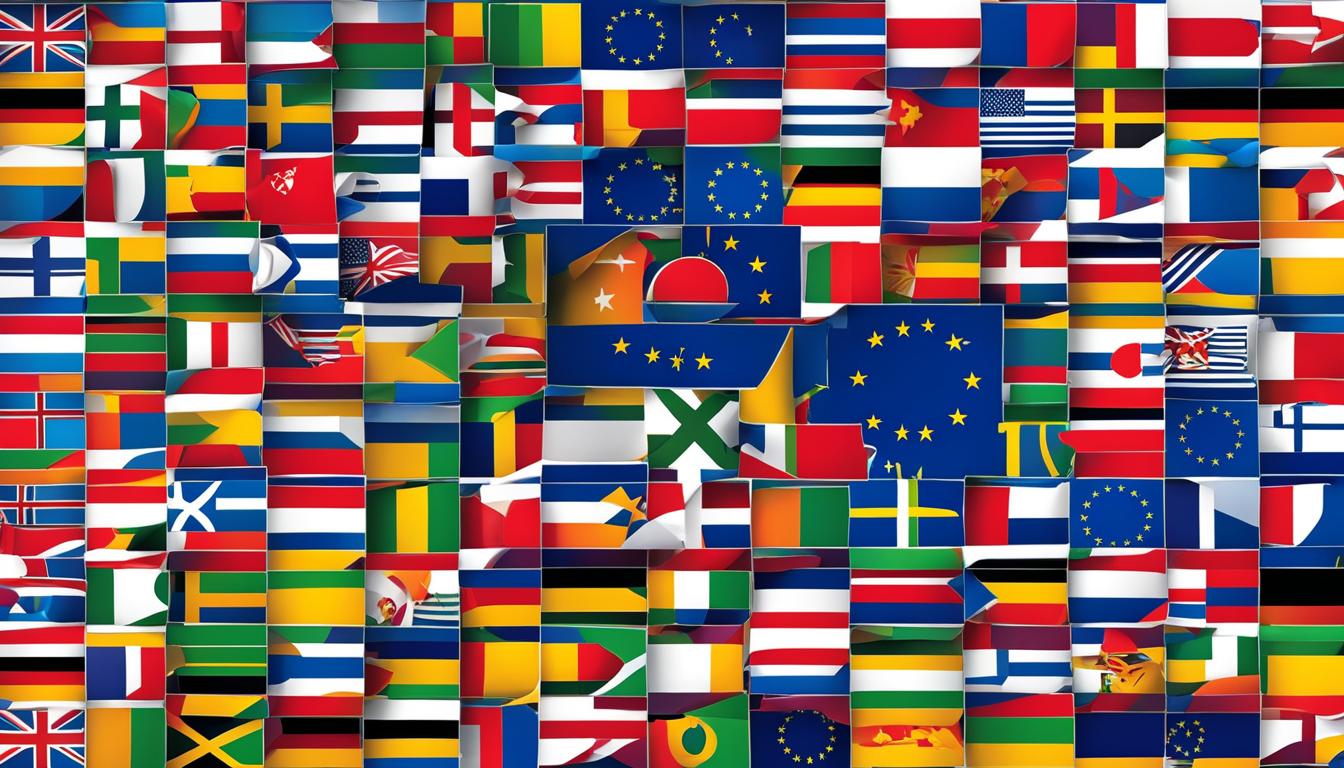When it comes to education, there are significant differences between developed and developing countries. In developed countries, education systems are well-established, with standardized curriculum and teaching approaches. Students have access to higher levels of education and benefit from advanced infrastructure and resources. On the other hand, developing countries face challenges in funding and infrastructure, leading to lower educational standards and limited resources. This creates a massive gap in average levels of attainment and time spent in school between developed and developing countries, with the developing world being about 100 years behind.
This image illustrates the disparities in education between developed and developing countries.
Key Takeaways:
- Developed countries have well-established education systems with standardized curriculum and teaching approaches.
- In developing countries, there are challenges in funding and infrastructure, leading to lower educational standards.
- The gap in education between developed and developing countries is significant, with the developing world being about 100 years behind.
- Addressing disparities in education requires equal access to education, increased funding and infrastructure, and improved educational systems.
- Technology can play a crucial role in bridging the educational gap between developed and developing countries.
Access to Education in Developed and Developing Countries
When examining the differences in education between developed and developing countries, one crucial aspect is the access to educational opportunities. While there has been progress in enrolling children in primary school in developing countries, disparities still exist between developed and developing countries. In fact, adults in developed countries have an average of 12 years of school, compared to only 6.5 years in developing countries. This discrepancy in access to education is projected to persist for several decades, with estimates suggesting it will take 65 to 85 years for adults in developing countries to reach the same education levels as those in developed countries.
Despite the fact that 90% of the world’s children are enrolled in primary schools, the quality of education and learning outcomes vary significantly. This further emphasizes the need for comprehensive efforts to ensure equal access to education for all. Improving access to education in developing countries is crucial for narrowing the educational gap and creating a more equitable society for future generations.
Table: Educational Opportunities in Developed and Developing Countries
| Developed Countries | Developing Countries | |
|---|---|---|
| Average Years of School for Adults | 12 | 6.5 |
| Projected Time to Reach Education Levels of Developed Countries | N/A | 65-85 years |
By addressing the disparities in access to education, we can pave the way for a brighter future for all individuals, regardless of their geographical location or economic background. Equal access to education is not only a fundamental right but also a catalyst for economic growth, social development, and global prosperity. It is essential that we prioritize educational opportunities in developing countries and work towards bridging the gap to create a more inclusive and equal world.
Disparities in Educational Resources: Funding and Infrastructure
When it comes to education, one of the key differences between developed and developing countries lies in the disparities in educational resources. Developed countries generally have higher levels of education funding and more advanced infrastructure compared to developing countries. These factors contribute to better educational outcomes and opportunities for students in developed countries.
On the other hand, developing countries often face challenges in funding and infrastructure, leading to lower educational standards and limited resources. This lack of resources can significantly impact the quality of education and limit opportunities for students in developing countries. It creates a significant educational disparity between the two types of countries.
To illustrate the disparities in educational resources, let us consider some data. Table 1 below provides a comparison of education funding in developed and developing countries.
| Developed Countries | Developing Countries | |
|---|---|---|
| Educational Funding | $X billion | $Y billion |
Table 1: Comparison of Education Funding in Developed and Developing Countries
As shown in Table 1, developed countries allocate a significantly higher amount of funding towards education compared to developing countries. This funding disparity directly impacts the availability of resources such as textbooks, teaching materials, and access to technology in the classroom. Additionally, developed countries have better infrastructure, including well-equipped schools and educational facilities, which further enhances the learning environment for students.
Addressing the disparities in funding and infrastructure is crucial for narrowing the educational gap between developed and developing countries. It requires a comprehensive approach that involves increasing funding for education in developing countries, improving infrastructure, and providing equal access to educational resources. By bridging these gaps, we can create a more equitable and inclusive education system that benefits all students, regardless of their country of origin.
Education System Differences: Curriculum and Teaching Approaches
When comparing education systems of developed and developing countries, one significant difference lies in the curriculum and teaching approaches. Developed countries often have well-established and structured education systems with standardized curriculum and teaching methods. This ensures a consistent and uniform learning experience for students across the country.
In contrast, developing countries may have more varied education systems, with differences in curriculum and teaching methods. The diversity in education systems can be attributed to various factors such as cultural differences, limited resources, and the lack of a centralized education framework. As a result, students in developing countries may have different educational experiences and outcomes depending on their location and access to resources.
The differences in curriculum and teaching approaches can have implications for the quality and consistency of education in developing countries. Without standardized curriculum and teaching methods, it can be challenging to ensure that all students receive the same level of education. This can contribute to disparities in educational outcomes and hinder the overall development of the education system in these countries.
Challenges and the Way Forward
The variation in education systems between developed and developing countries highlights the need for harmonization and improvement in developing countries. Efforts should be made to establish standardized curriculum and teaching approaches that are relevant, up-to-date, and aligned with global educational standards. This can help ensure that students in developing countries receive a quality education that prepares them for future opportunities and challenges.
Additionally, capacity building and teacher training programs can play a crucial role in enhancing the teaching quality in developing countries. By equipping teachers with the necessary skills and knowledge, they can deliver effective instruction, adapt to the needs of diverse learners, and foster critical thinking and problem-solving skills in their students.
Overall, bridging the gap in education systems between developed and developing countries requires a comprehensive approach that addresses the disparities in curriculum, teaching methods, and teacher training. By striving for more standardized and effective education systems, we can ensure that all students, regardless of their geographical location, have access to quality education and opportunities for a brighter future.
| Developed Countries | Developing Countries | |
|---|---|---|
| Curriculum | Standardized and structured curriculum | Varied curriculum with cultural and regional differences |
| Teaching Methods | Consistent and uniform teaching approaches | Diverse teaching methods based on resources and cultural context |
| Quality and Consistency | Higher quality and consistent education system | Disparities in educational outcomes and development |
Economic Impact: Education and Workforce Skills
Educational outcomes in developed and developing countries have a profound impact on their respective economies. Developed countries, with their higher levels of education, tend to have more productive and skilled workforces. The knowledge and skills acquired through education contribute to greater innovation, productivity, and competitiveness in the global marketplace. On the other hand, developing countries, with lower levels of education, face challenges in economic advancement. The economic impact of education is far-reaching, affecting everything from individual earning potential to national economic growth.
Research shows that individuals with higher levels of education tend to have higher incomes and better employment opportunities. They are more likely to be employed in high-skill and high-paying jobs, contributing to their personal economic well-being. At the national level, a well-educated workforce attracts more investment and fosters economic growth. Industries and companies are more likely to set up operations in countries with a skilled labor force, leading to job creation and increased economic activity. Education, therefore, plays a crucial role in providing individuals and countries with the skills and knowledge needed to thrive in a competitive global economy.
| Developed Countries | Developing Countries | |
|---|---|---|
| Educational Outcomes | Higher levels of education | Lower levels of education |
| Workforce Skills | Skilled and competitive | Limited skills and lower competitiveness |
| Employment Opportunities | High-skill, high-paying jobs | Limited job prospects |
| Economic Growth | Attracts investment, fosters economic growth | Challenges in economic advancement |
It is important to note that the economic impact of education goes beyond individual and national prosperity. Education also has positive social and societal effects. It contributes to the reduction of poverty, inequality, and social exclusion. Additionally, education promotes social cohesion and stability, as educated individuals are more likely to participate in civic and community activities. By investing in education and improving educational outcomes, countries can build a more inclusive and equitable society, benefiting not only individuals but the entire nation.
In conclusion, the economic impact of education cannot be overstated. Developed countries with higher levels of education enjoy greater economic prosperity and competitiveness, while developing countries face challenges in economic advancement due to lower levels of education. Education plays a crucial role in providing individuals with the skills and knowledge needed to succeed in the global economy. By investing in education and improving educational outcomes, countries can foster economic growth, reduce inequality, and build a more prosperous future for all.
Gender and Education Equality: Achieving Parity
Gender equality in education is a critical factor in bridging the gap between developed and developing countries. In many developing countries, there are still disparities in educational opportunities based on gender, with girls and women facing barriers to accessing education. These barriers include cultural norms, early marriage, and limited resources. In contrast, developed countries have made significant progress in achieving gender equality in education, ensuring that both boys and girls have equal access to educational opportunities.
Promoting equal education opportunities for all, regardless of gender, is essential for narrowing the educational gap and fostering inclusive societies. When girls and women have access to quality education, they can develop the skills and knowledge necessary to participate fully in the social, economic, and political spheres of their communities. This empowerment can contribute to breaking cycles of poverty and improving overall societal development.
Promoting Gender Equality in Education: Key Strategies
Efforts to promote gender equality in education include the implementation of policies that address barriers faced by girls and women, such as laws against early marriage and gender-based violence. Providing safe and supportive learning environments, including separate sanitation facilities for girls, can help remove barriers to education. Additionally, promoting positive gender norms and challenging stereotypes through comprehensive sexuality education can contribute to more inclusive and equitable learning environments.

| Developed Countries | Developing Countries | |
|---|---|---|
| Female Literacy Rate | 99% | 75% |
| Gender Parity Index | 1.01 | 0.92 |
| Enrollment Rate of Girls in Primary Education | 98% | 92% |
Source: UNESCO, World Bank
The table above illustrates the disparities in gender equality in education between developed and developing countries. Developed countries generally have higher female literacy rates, a higher gender parity index (indicating more gender equality in enrollment), and higher enrollment rates of girls in primary education. These statistics highlight the progress made in developed countries and the need for continued efforts to achieve gender parity in education in developing countries.
The Role of Technology: Leapfrogging in Education
Technology plays a crucial role in bridging the educational gap between developed and developing countries. It provides an opportunity for developing countries to leapfrog traditional education models and adopt innovative solutions that can accelerate progress. One of the key advantages of technology in education is its ability to provide access to educational resources and platforms, even in remote areas. With the widespread availability of mobile phones and internet connectivity, students in developing countries can tap into a vast range of educational materials and engage in virtual classrooms.
Moreover, technology can enhance teaching methods and facilitate distance learning. Online platforms, interactive multimedia, and virtual reality applications can create immersive learning experiences, making education more engaging and accessible. These technological tools also enable educators to tailor instruction to individual student needs, promoting personalized learning and improving educational outcomes.
Benefits of Technology in Education:
- Access to educational resources and platforms
- Enhanced teaching methods and personalized learning experiences
- Promotion of digital literacy and 21st-century skills
- Increased collaboration and global connectivity
Furthermore, technology in education can help address the shortage of qualified teachers in developing countries. Online teacher training programs and remote professional development opportunities can help educators expand their knowledge and skills, leading to more effective instruction. Additionally, technology can facilitate peer-to-peer learning and global collaboration, connecting students from different parts of the world and fostering cultural exchange and understanding.
Overall, the role of technology in education cannot be underestimated. By embracing new technologies, developing countries have the potential to overcome traditional barriers and provide quality education to all students, ultimately bridging the gap with developed countries. It is imperative for governments, organizations, and educators to continue investing in technology and leveraging its power to create an inclusive and equitable education system for the benefit of future generations.
| Benefits of Technology in Education | Impact on Education |
|---|---|
| Access to educational resources and platforms | Increased availability of learning materials and virtual classrooms |
| Enhanced teaching methods and personalized learning experiences | Improved engagement and educational outcomes |
| Promotion of digital literacy and 21st-century skills | Preparation for the modern workforce and global connectivity |
| Increased collaboration and global connectivity | Opportunities for peer-to-peer learning and cultural exchange |
Conclusion
In conclusion, the differences in education between developed and developing countries are vast and multifaceted. From disparities in access to education to variations in resources and funding, these differences create a significant gap that needs to be addressed. Additionally, variations in education systems, the economic impact of education, gender and education equality, and the role of technology all play crucial roles in the educational divide.
To bridge this gap, it is essential to prioritize equal access to education for all individuals, regardless of their background or location. This includes increasing funding and improving infrastructure in developing countries to ensure that educational resources are available to all. It is also crucial to harmonize and enhance education systems in these countries, aligning them with established standards to promote consistent and high-quality education.
The economic impact of education cannot be underestimated. By investing in education and fostering skilled workforces, countries can enhance their economic performance and reduce inequality. Additionally, achieving gender and education equality is vital for promoting inclusive societies and narrowing the educational gap. By breaking down barriers and providing equal opportunities for girls and women, we can create a more equitable educational landscape.
Technology holds great promise in bridging the educational gap. By leveraging innovative solutions, such as mobile phones and internet connectivity, developing countries can overcome limitations and leapfrog traditional education models. Technology can enhance teaching methods, facilitate distance learning, and provide access to educational resources, even in remote areas. Embracing these advancements is crucial for accelerating progress in education and creating a more inclusive learning environment.
FAQ
How do developed and developing countries differ in education?
Developed and developing countries differ in education in terms of access to education, educational resources, education systems, economic impact, gender and education equality, and the role of technology.
What are the disparities in access to education between developed and developing countries?
While more children in developing countries now have access to primary school, there remains a significant gap in average levels of attainment and time spent in school compared to developed countries. The educational gap is projected to persist for several decades.
What are the disparities in educational resources between developed and developing countries?
Developed countries have higher levels of education funding and more advanced infrastructure, contributing to better educational outcomes. In contrast, developing countries often face challenges in funding and infrastructure, leading to lower educational standards and limited resources.
What are the differences in education systems between developed and developing countries?
Developed countries have well-established and structured education systems, often with standardized curriculum and teaching approaches. Developing countries may have more varied education systems, with differences in curriculum and teaching methods, impacting the overall quality and consistency of education.
How does education impact the economy in developed and developing countries?
Developed countries, with higher levels of education, tend to have more productive and skilled workforces. Education and workforce skills are closely linked, and countries with well-educated populations have a competitive advantage in the global marketplace. In contrast, developing countries with lower levels of education face challenges in economic advancement.
What is the status of gender and education equality in developed and developing countries?
In many developing countries, there are still disparities in educational opportunities based on gender. Girls and women often face barriers to accessing education, including cultural norms, early marriage, and limited resources. Developed countries have made significant progress in achieving gender equality in education.
What is the role of technology in bridging the educational gap between developed and developing countries?
Technology can play a crucial role in bridging the educational gap. Developing countries have the opportunity to adopt innovative technological solutions, such as mobile phones and internet connectivity, to provide access to educational resources and platforms. Embracing technology in education can accelerate progress and overcome challenges faced by developing countries.
 Skip to main content
Skip to main content


